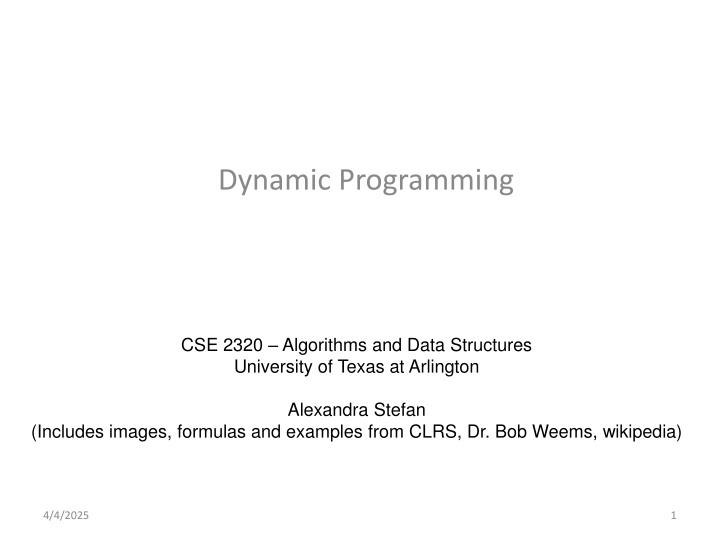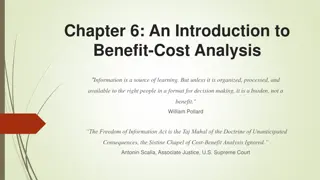Budget Development Workshop Objectives and Cost Analysis
This workshop focuses on identifying different types of costs, including direct and indirect costs, calculating salaries and fringe benefits, outlining requirements for graduate students and collaborators, and understanding indirect cost rates. It also covers the allowability of costs, including necessary criteria and documentation. The session delves into specific cost elements such as salaries, fringe benefits, graduate student requirements, and other direct costs like equipment, travel, and participant support.
Download Presentation

Please find below an Image/Link to download the presentation.
The content on the website is provided AS IS for your information and personal use only. It may not be sold, licensed, or shared on other websites without obtaining consent from the author.If you encounter any issues during the download, it is possible that the publisher has removed the file from their server.
You are allowed to download the files provided on this website for personal or commercial use, subject to the condition that they are used lawfully. All files are the property of their respective owners.
The content on the website is provided AS IS for your information and personal use only. It may not be sold, licensed, or shared on other websites without obtaining consent from the author.
E N D
Presentation Transcript
Dynamic Programming CSE 2320 Algorithms and Data Structures University of Texas at Arlington Alexandra Stefan (Includes images, formulas and examples from CLRS, Dr. Bob Weems, wikipedia) 4/4/2025 1
Approaches for solving DP Problems Greedy - typically not optimal solution (for DP-type problems) - Build solution - Use a criterion for picking - Commit to a choice and do not look back DP - Optimal solution - Write math function, sol, that captures the dependency of solution to current pb on solutions to smaller problems - Can be implemented in any of the following: iterative, memoized, recursive Brute Force - Optimal solution - Produce all possible combinations, [check if valid], and keep the best. - Time: exponential - Space: depends on implementation - It may be hard to generate all possible combinations Iterative (bottom-up) - BEST - Optimal solution - sol is an array (1D or 2D). Size: n+1 - Fill in sol from 0 to n - Time: polynomial (or pseudo- polynomial for some problems) - Space: polynomial (or pseudo- polynomial - To recover the choices that gave the optimal answer, must backtrace => must keep picked array (1D or 2D). Memoized - Optimal solution - Combines recursion and usage of sol array. - sol is an array (1D or 2D) - Fill in sol from 0 to n - Time: same as iterative version (typically) - Space: same as iterative version (typically) + space for frame stack. (Frame stack depth is typically smaller than the size of the sol array) Recursive - Optimal solution - Time: exponential (typically) => - DO NOT USE - Space: depends on implementation (code). E.g. store all combinations, or generate, evaluate on the fly and keep best seen so far. - Easy to code given math function Sliding window - Improves the iterative solution - Saves space - If used, cannot recover the choices (gives the optimal value, but not the choices) DP can solve: - some types of counting problems (e.g. stair climbing) - some type of optimization problems (e.g. Knapsack) - some type of recursively defined pbs (e.g. Fibonacci) Some DP solutions have pseudo polynomial time
Dynamic Programming (DP) - CLRS Dynamic programming (DP) applies when a problem has both of these properties: 1. Optimal substructure: optimal solutions to a problem incorporate optimal solutions to related subproblems, which we may solve independently . 2. Overlapping subproblems: a recursive algorithm revisits the same problem repeatedly . Dynamic programming is typically used to: Solve optimization problems that have the above properties. Solve counting problems e.g. Stair Climbing or Matrix Traversal. Speed up existing recursive implementations of problems that have overlapping subproblems (property 2) e.g. Fibonacci. Compare dynamic programming with divide and conquer. 3
Bottom-Up vs. Top Down There are two versions of dynamic programming. Bottom-up. Top-down (or memoization). Bottom-up: Iterative, solves problems in sequence, from smaller to bigger. Top-down: Recursive, start from the larger problem, solve smaller problems as needed. For any problem that we solve, store the solution, so we never have to compute the same solution twice. This approach is also called memoization. 4
Top-Down Dynamic Programming ( Memoization ) Maintain an array/table where solutions to problems can be saved. To solve a problem P: See if the solution has already been stored in the array. If yes, return the solution. Else: Issue recursive calls to solve whatever smaller problems we need to solve. Using those solutions obtain the solution to problem P. Store the solution in the solutions array. Return the solution. 5
Bottom-Up Dynamic Programming Requirements for using dynamic programming: The answer to our problem, P, can be easily obtained from answers to smaller problems. We can order problems in a sequence (P0, P1, P2, ..., PK) of reasonable size, so that: Pk is our original problem P. The initial problems, P0 and possibly P1, P2, ..., PR up to some R, are easy to solve (they are base cases). For i > R, each Pi can be easily solved using solutions to P0, ..., Pi-1. If these requirements are met, we solve problem P as follows: Create the sequence of problems P0, P1, P2, ..., PK, such that Pk = P. For i = 0 to K, solve PK. Return solution for PK. 6
Steps (Dr. Weems) 1. Identify problem input 2. Identify the cost/gain function (name it, describe it) 3. Give the math formula for the cost function for all cases: base cases and general case 4. Order the problems & solve them 5. Recover the choices that gave the optimal value Other 1. Brute force solution 2. Recursive solution (most likely exponential and inneficient) 3. Memoized solution 7
Fibonacci Numbers Generate Fibonacci numbers 3 solutions: inefficient recursive, memoization (top-down dynamic programming (DP)), bottom-up DP. Not an optimization problem but it has overlapping subproblems => DP eliminates recomputing the same problem over and over again. Weighted interval scheduling Matrix multiplication 9
Fibonacci Numbers Fibonacci(0) = 0 Fibonacci(1) = 1 If N >= 2: Fibonacci(N) = Fibonacci(N-1) + Fibonacci(N-2) How can we write a function that computes Fibonacci numbers? 10
Fibonacci Numbers Fibonacci(0) = 0 Fibonacci(1) = 1 If N >= 2: Fibonacci(N) = Fibonacci(N-1) + Fibonacci(N-2) Consider this function: what is its running time? Notice the mapping/correspondence of the mathematical expression and code. int Fib(int i) { if (i < 1) return 0; if (i == 1) return 1; return Fib(i-1) + Fib(i-2); } 11
Fibonacci Numbers Fibonacci(0) = 0 Fibonacci(1) = 1 If N >= 2: Fibonacci(N) = Fibonacci(N-1) + Fibonacci(N-2) Consider this function: what is its running time? g(N) = g(N-1) + g(N-2) + constant g(N) Fibonacci(N) => g(N) = (Fibonacci(N)) => g(N) = (1.618N) Also g(N) 2g(N-1)+constant => g(N) c2N => g(N) is exponential We cannot compute Fibonacci(40) in a reasonable amount of time (with this implementation). => g(N) = O(2N) int Fib(int i) { if (i < 1) return 0; if (i == 1) return 1; return Fib(i-1) + Fib(i-2); } See how many times this function is executed. Draw the tree 12
Fibonacci Numbers Fibonacci(0) = 0 Fibonacci(1) = 1 If N >= 2: Fibonacci(N) = Fibonacci(N-1) + Fibonacci(N-2) Alternative to inefficient recursion: compute from small to large and store data in an array. Notice the mapping/correspondence of the mathematical expression and code. linear version (Iterative, bottom-up ): int Fib_iter (int i) { int F[i+1]; F[0] = 0; F[1] = 1; int k; for (k = 2; k <= i; k++) F[k] = F[k-1] + F[k-2]; return F[i]; } exponential version: int Fib(int i) { if (i < 1) return 0; if (i == 1) return 1; return Fib(i-1) + Fib(i-2); } 13
Applied scenario F(N) = F(N-1)+F(N-2), F(0) = 0, F(1) = 1, Consider a webserver where clients can ask what the value of a certain Fibonacci number, F(N) is, and the server answers it. How would you do that? (the back end, not the front end) (Assume a uniform distribution of F(N) requests over time most F(N) will be asked.) Constraints: Each loop iteration or function call costs you 1cent. Each loop iteration or function call costs the client 0.001seconds wait time Memory is cheap How would you charge for the service? (flat fee/function calls/loop iterations?) Think of some scenarios of requests that you could get. Think of it with focus on: good sequence of requests bad sequence of requests Is it clear what good and bad refer to here? 14
Fibonacci Numbers Fibonacci(0) = 0 , Fibonacci(1) = 1 If N >= 2: Fibonacci(N) = Fibonacci(N-1) + Fibonacci(N-2) Alternative: remember values we have already computed. Draw the new recursion tree and discuss time complexity. memoized version: int Fib_mem_wrap(int i) { int sol[i+1]; if (i<=1) return i; sol[0] = 0; sol[1] = 1; for(int k=2; k<=i; k++) sol[k]=-1; Fib_mem(i,sol); return sol[i]; } int Fib_mem (int i, int[] sol) { if (sol[i]!=-1) return sol[i]; int res = Fib_mem(i-1, sol) + Fib_mem(i-2, sol); sol[i] = res; return res; } exponential version: int Fib(int i) { if (i < 1) return 0; if (i == 1) return 1; return Fib(i-1) + Fib(i-2); } 15
Fibonacci and DP Computing the Fibonacci number is a DP problem. It is a counting problem (not an optimization one). We can make up an applied problem for which the DP solution function is the Fibonacci function. Consider: A child can climb stairs one step at a time or two steps at a time (but he cannot do 3 or more steps at a time). How many different ways can they climb? E.g. to climb 4 stairs you have 5 ways: {1,1,1,1}, {2,1,1}, {1,2,1}, {1,1,2}, {2,2} 16
The Knapsack Problem Problem: A thief breaks into a store. The maximum total weight that he can carry is W. There are N types of items at the store. Each type ti has a value vi and a weight wi. What is the maximum total value that he can carry out? What items should he pick to obtain this maximum value? Variations based on item availability: Unlimited amounts Unbounded Knapsack Limited amounts Bounded Knapsack Only one item 0/1 Knapsack Items can be cut Continuous Knapsack (or Fractional Knapsack) Image from Wikipedia: https://en.wikipedia.org/wiki/Knapsack_problem 17
Variations of the Knapsack Problem Fractional: For each item can take the whole quantity, or a fraction of the quantity. Unbounded: Have unlimited number of each object. Can pick any object, any number of times. (Same as the stair climbing with gain.) Bounded: Have a limited number of each object. Can pick object i, at most xi times. flour soda All versions have: N number of different types of objects 0-1 (special case of Bounded): Have only one of each object. Can pick either pick object i, or not pick it. This is on the web. W the maximum capacity (kg) v1, v2, ,vN w1, w1, , wN, Value for each object. ($$) Weight of each object. (kg) The bounded version will have the amounts: c1,c2, , cN of each item. 18
Worksheet: Unbounded Knapsack Max capacity: W=17 Item type: Math cost function: ??? ? = 0, ? < min A B C D E 1 ? ??? Weight (kg) 3 4 7 8 9 (???? ?????,?? ???? ????) ??? ? = max ?,?.?.?? ? (1 ? ?) Value ($$) 4 6 11 13 15 {????+ ???(? ??)} Where ? = ??????? ???? ? = ??????? ??????? ???? index 0 1 2 3 4 5 6 7 8 9 10 11 12 13 14 15 16 17 solution Sol Picked Work (to compute solution) A, 3, 4 B, 4, 6 C, 7,11 D,8,13 E, 9,15 19 Rows A,B,C,D,E are used to compute the final solution, in Sol and Picked. They show your work.
Answers: Unbounded Knapsack index 0 1 2 3 4 5 6 7 8 9 10 11 12 13 14 15 16 17 Sol 0 0 0 4 6 6 8 11 13 15 15 17 19 21 22 24 26 28 Picked - - - A B B A C D E A A A B C C C D A, 3, 4 - - - 0,4 1,4 2,4 3,8 4, 10 5, 10 6, 12 7, 15 8, 17 9, 19 10, 19 11, 21 12, 23 13, 25 14, 26 B, 4, 6 - - - - 0, 6 1,6 2, 6 3, 10 4, 12 5, 12 6, 14 7, 17 8, 19 9, 21 10, 21 11, 23 12, 25 13, 27 C, 7,11 - - - - - - - 0, 11 1, 11 2, 11 3, 15 4, 17 5, 17 6, 19 7, 22 8, 24 9, 26 10, 26 D,8,13 - - - - - - - - 0, 13 1, 13 2, 13 3, 17 4, 19 5, 19 6, 21 7, 24 8, 26 9, 28 E,9,15 - - - - - - - - - 0, 15 1, 15 2, 15 3, 19 4, 21 5, 21 6, 23 7, 26 8, 28 20 Red optimal, underscore value(money)
Unbounded Knapsack recover the items Find the items that give the optimal value. For example in the data below, what items will give me value 31 for a max weight of 22? Note that the item values are different from those on the previous page. (They are from a different problem instance.) Item type: A B C D E Weight (kg) 3 4 7 8 9 ID of picked item Kg 0 1 2 3 4 5 6 7 8 ID -1 -1 -1 A B B A C D E A A A A C A C A E A A A A $$ 0 0 0 4 5 5 8 10 11 13 14 15 17 18 20 21 23 24 26 27 28 30 31 9 10 11 12 13 14 15 16 17 18 19 20 21 22 21
Unbounded Knapsack recover the items Find the items that give the optimal value. For example in the data below, what items will give me value 31 for a max weight of 22? Note that the item values are different from those on the previous page. (They are from a different problem instance.) Item type: A B C D E Weight (kg) 3 4 7 8 9 weight(A) 19=22-3 weight(C) 9 = 16 - 7 3 weight(E) 0 = 9 - 9 16=19-3 Kg 0 1 2 3 4 5 6 7 8 ID -1 -1 -1 A B B A C D E A A A A C A C A E A A A A $$ 0 0 0 4 5 5 8 10 11 13 14 15 17 18 20 21 23 24 26 27 28 30 31 9 10 11 12 13 14 15 16 17 18 19 20 21 22 Answer: E, C, A, A 22
Warning! Webpage:https://www.codeproject.com/Articles/706838/Bounded-Knapsack-Algorithm The presented solution for the unbounded knapsack: The unbounded knapsack problem is fairly easy to solve: Determine the value-weight ratio of every item. Starting with the highest value-weight ratio item, place as many of this item as will fit into the sack. Move onto the next-highest value-weight item and repeat step 2 until the sack is full or there are no other items. What is described there is the Greedy version, which will NOT give the optimal answer for all problems. Try to verify what you read on the web: Use trusted sites such as Wikipedia, See if you get the same answer from several sources. Check blog posts 23
Iterative Solution for Unbounded Knapsack /* Assume arrays v and w store the item info starting at index 1: first item has value v[1] and weight w[1] */ int knapsack(int W, int n, int * v, int * w){ int sol[W+1]; int picked[W+1]; sol[0] = 0; for(k=1; k<=W; k++) { mx = 0; choice = -1; // no item for(i=1;i<n;i++) { if (k>=w[i]) { with_i = v[i]+sol[k-w[i]]; if (mx < with_i) { mx = with_i; choice = i; } }// for i sol[k]=mx; picked[k] = choice; }// for k return sol[W]; } //Time: (nW) [pseudo polynomial: store W in lgW bits] Space: (W) Math cost function: ??? ? = 0, ? < min 1 ? ??? (???? ?????,?? ???? ????) ??? ? = max ?,?.?.?? ? (1 ? ?) Where ? = ??????? ???? ? = ??????? ??????? ???? {????+ ???(? ??)} 24
Memoized Solution for Unbounded Knapsack int knapsack(int W, int n, int * v, int * w){ int sol[W+1]; sol[0] = 0; // value 0 (cannot carry anything) for(k=1; k<W; k++) sol[k] = -1; // negative, safe return = knap_helper(W, n, v, w, sol); } /* Assume arrays v and w store the item info starting at index 1: first item has value v[1] and weight w[1] */ int knap_helper(int k, int n, int * v, int * w, int* sol){ if (sol[k] != -1) return sol[k]; // check if already computed mx = 0; for(i=1;i<n;i++) { if (k>=w[i]) { with_i = v[i]+ knap_helper(k-w[i], n, v, w, sol); if (mx < with_i) mx = with_i; }// for i sol[k]=mx; // remember to save the computation in sol ! return mx; }// Time: (nW) [pseudo polynomial] Space: (W) (for sol and stack) 25
Recursive Solution (OPTIONAL) Math cost function: ??? ? = 0, ? < min 1 ? ??? (???? ?????,?? ???? ????) ??? ? = max ?,?.?.?? ? (1 ? ?) {????+ ???(? ??)} Where ? = ??????? ???? ? = ??????? ??????? ???? We want to compute: knap(17). knap(17) will be the maximum of these five values: item type: weight: value A B C D E 3 4 7 8 9 4 6 11 13 15 int knapsack(int W, int n, int * v, int * w){ if (W == 0) return 0; int max_value = 0; int i; for (i = 1; i <= n; i++) { if (W < w[i]) continue; int value = v[i] + knapsack(W-w[i],n,v,w); if (value > max_value) max_value = value; } return max_value; } val_A = 4 + knap(14) val_B = 6 + knap(13) val_C = 11 + knap(10) val_D = 13 + knap(9) val_E = 15 + knap(8) 26
Recursive Solution for Knapsack (OPTIONAL) running time? very slow (exponential) int knapsack(int W, int n, int * v, int * w){ if (W == 0) return 0; int max_value = 0; int i; for (i = 1; i <= n; i++) { if (W < w[i]) continue; int value = v[i] + knapsack(W-w[i],n,v,w); if (value > max_value) max_value = value; } return max_value; } How can we make it faster? 27
Draw the recursion tree (OPTIONAL) Inefficient recursion Memoized version 28
Time complexity Note that the recursive inefficient version is a brute force solution (it generates all sets with total weight less than the knapsack capacity) B.c. it recalculates every smaller problem Draw the recursion tree. Discuss the time complexity of all 3 methods. Let W = maxWeight, n = number of different items Bottom-up (iterative): O(W * n) Imagine case with an item of weight 1. Pseudo-polynomial polynomial in the value of one of the inputs: W. Recursive with memoization: O(W*n) Worst case tree height is W, every problem size is at most solved once (as an internal node) every internal node will have at most n branches. Inefficient recursion: O(nW) (assume all items have weight 1) 29
Performance Comparison Recursive version: (knapsack_recursive.c) Runs reasonably fast for max_weight <= 60. Starts getting noticeably slower after that. For max_weight = 75 I gave up waiting after 3 minutes. Bottom-up version: (knapsack_bottom_up.c) Tried up to max_weight = 100 million. No problems, very fast. Took 4 seconds for max_weight = 100 million. Top-down version: (knapsack_top_down.c) Very fast, but crashes around max_weight = 57,000. The system cannot handle that many recursive function calls. 30
Worksheet: 0/1 Knapsack (not fractional) optimal solution (for a smaller problem size), excluding item i Math cost function: ??? 0,? = 0, ? Sol(i, k) = 0, , ? s.t. ? < min optimal solution (for this problem size), excluding item i 0 ? ??? ??? ?,? = max{??? ? 1,? ,?? + ???(? 1,? ??)} Where ? = ??????? ???? ? = ??????? ??????? ???? Value_using_first_i_items: Sol[i] [k] = max{Sol[i-1] [ k w[i]] + v[i], Sol[i-1] [k] index 0 1 2 3 4 5 6 7 8 9 10 11 12 13 14 15 16 17 No item A, 3, 4 B, 4, 6 C, 7,11 D,8,13 E, 9,15 31
Answer: 0/1 Knapsack (not fractional) optimal solution (for a smaller problem size), excluding item i Math cost function: ??? 0,? = 0, ? Sol(i, k) = 0, , ? s.t. ? < min optimal solution (for this problem size), excluding item i 0 ? ??? ??? ?,? = max{??? ? 1,? ,?? + ???(? 1,? ??)} Where ? = ??????? ???? ? = ??????? ??????? ???? Value_using_first_i_items: Sol[i] [k] = max{Sol[i-1] [ k w[i]] + v[i], Sol[i-1] [k] E.g.: Value_using_first_3_items(A,B,C): Sol[3] [14] = max{Sol[2] [14 - 7] +11, Sol[2] [7] = max{10+11, 10} = 21 index 0 1 2 3 4 5 6 7 8 9 10 11 12 13 14 15 16 No item 0 0 0 0 0 0 0 0 0 0 0 0 0 0 0 0 0 0 A, 3, 4 0 0 0 4* 4* 4* 4* 4* 4* 4* 4* 4* 4* 4* 4* 4* 4* 1 B, 4, 6 0 0 0 4 6* 6* 6* 10* 10* 10* 10* 10* 10* 10* 10* 10* 10* 2 +11 C, 7,11 0 0 0 4 6 6 6 11* 11* 11* 15* 17* 17* 17* 21* 21* 21* 3 D,8,13 0 0 0 4 6 6 6 11 13* 13* 15 17* 19* 19* 21 24* 24* 4 E, 9,15 0 0 0 4 6 6 6 11 13 15* 15* 17 19* 21* 21* 24 26* 5 32
Iterative Solution for 0/1 Knapsack /* Assume arrays v and w store the item info starting at index 1: first item has value v[1] and weight w[1] */ int knapsack01(int W, int n, int * v, int * w){ int sol[n+1][W+1]; for(k=0; k<=W; k++) { sol[0][k] = 0;} for(i=1; i<=n; i++) { for(k=0;k<=W;k++) { sol[i][k] = sol[i-1][k]; // solution without item i if (k>w[i]) { with_i = v[i]+sol[i-1][k-w[i]]; if (sol[i][k] < with_i) { // better choice sol[i][k] = with_i; // keep it } } }// for k }// for i return sol[n][W]; } // Time: (nW) Space: (nW) [pseudo polynomial] 33
Unbounded vs 0/1 Knapsack Solutions Unbounded (unlimited number of items) Need only one (or two) 1D arrays: sol (and picked). The other rows (one per item) are added to show the work that we do in order to figure out the answers that go in the table. There is NO NEED to store it. Similar problem: Minimum Number of Coins for Change (solves a minimization, not a maximization problem): https://www.youtube.com/watch?v=Y0ZqKpToTic 0/1 (most web resources show this problem) MUST HAVE one or two 2D tables, of size: (items+1) x (max_weight+1). Each row (corresponding to an item) gives the solution to the problem using items from the beginning up to and including that row. Whenever you look back to see the answer for a precomputed problem you look precisely on the row above because that gives a solution with the items in the rows above (excluding this item). Unbounded knapsack can repeat the item => no need for sol excluding the current item => 1D 34
Sliding Window (improves memory usage) Optimize the memory usage: store only smaller problems that are needed. NOTE: if a sliding window is used the choices cannot be recovered (i.e. cannot recover what items to pick to achieve the computed optimal value). Unbounded : the sliding window size is the max of the items weights => (maxi(wi)) 0/1: the sliding window is 2 rows from the table => (W) Draw the sliding window arrays for the above problems. How do you update the arrays? 35
Hint for DP problems For a DP problem you can typically write a MATH function that gives the solution for problem of size N in terms of smaller problems. It is straightforward to go from this math function to code: Iterative: The math function maps to the sol array Recursive: The math function maps to recursive calls Typically the math function will be a Min/max (over itself applied to smaller N) Sum (over itself applied to smaller N) 36
Weighted Interval Scheduling (Job Scheduling) 37
Weighted Interval Scheduling (a.k.a. Job Scheduling) E.g.: (start, end, value) (6, 8, $2) (2, 5, $6) (3, 11, $5) (5, 6, $3) (1, 4, $5) (4, 7, $2) Problem: Given n jobs where each job has a start time, finish time and value, (si,fi,vi) select a subset of them that do not overlap and give the largest total value. After preprocessing: JobId (start, end, value, p(i)) 1 (1, 4, $5, ) 2 (2, 5, $6, ) 3 (5, 6, $3, ) 4 (4, 7, $2, ) 5 (6, 8, $2, ) 6 (3, 11, $5, ) Preprocessing: Sort jobs in increasing order of their finish time. For each job ,i, compute the last job prior to i, p(i), that does not overlap with i. 38
Weighted Interval Scheduling (a.k.a. Job Scheduling) Problem: Given n jobs where each job has a start time, finish time and value, (si,fi,vi) select a subset of them that do not overlap and give the largest total value. Preprocessing: Sort jobs in increasing order of their finish time. already done here For each job ,i, compute the last job prior to i, p(i), that does not overlap with i. Solve the problem: Steps: one step for each job. Option: pick it or not Smaller problems: 2: pb1 = jobs 1 to i-1, => sol(i-1) pb2 = jobs 1 to p(i) (where p(i) is the last job before i that does not overlap with i. => sol(p(i)) Solution function: sol(0) = 0 ??? ? = max{??? ? 1 ,? ? + ???(? ? )} Time complexity: O(n) ( Fill out sol(i) in constant time for each i) 39
After preprocessing (sorted by END time): JobId (start, end, value, p(i)) 1 (1, 4, $5, __ ) 2 (2, 5, $6, __ ) 3 (5, 6, $3, __ ) 4 (4, 7, $2, __ ) 5 (6, 8, $2, __ ) 6 (3, 11, $5, __ ) Solve the problem: Steps: one step for each job. Option: pick it or not (pick job i or not pick it) Smaller problems: 2: pb1 = jobs 1 to i-1, => sol(i-1) pb2 = jobs 1 to p(i) (where p(i) is the last job before i that does not overlap with i. => sol(p(i)) Solution function: sol(0) = 0 ??? ? = max{??? ? 1 ,? ? + ???(? ? )} Original problem: (start, end, value) (6, 8, $2) (2, 5, $6) (3, 11, $5) (5, 6, $3) (1, 4, $5) (4, 7, $2) Time complexity: ______ i vi pi sol(i) sol(i) used i In optimal solution 0 40 Optimal value: ____, jobs picked to get this value: _________
After preprocessing (sorted by END time): JobId (start, end, value, p(i)) 1 (1, 4, $5, _0_ ) 2 (2, 5, $6, _0_ ) 3 (5, 6, $3, _2_ ) 4 (4, 7, $2, _1_ ) 5 (6, 8, $2, _3_ ) 6 (3, 11, $5, _0_ ) Solve the problem: Steps: one step for each job. Option: pick it or not (pick job i or not pick it) Smaller problems: 2: pb1 = jobs 1 to i-1, => sol(i-1) pb2 = jobs 1 to p(i) (where p(i) is the last job before i that does not overlap with i. => sol(p(i)) Solution function: sol(0) = 0 ??? ? = max{??? ? 1 ,? ? + ???(? ? )} Original problem: (start, end, value) (6, 8, $2) (2, 5, $6) (3, 11, $5) (5, 6, $3) (1, 4, $5) (4, 7, $2) Time complexity: O(n) ( Fill in sol(i) in constant time for each i) i vi 0 pi -1 sol(i) sol(i) used i In optimal solution 0 0 - 1 5 0 5 = max{0, 5+0} Y 2 6 0 6 = max{5, 6+0} Y Y 3 3 2 9 = max{6, 3+6} Y Y 4 2 1 9 = max{9, 2+5} N 5 2 3 11 = max{9, 2+9} Y Y 6 5 0 11 = max{11, 5+0} N 41 Optimal value: 11, jobs picked to get this value: 2,3,5
Another example Notations conventions: Jobs are already sorted by end time Horizontal alignment is based on time. In this example, only consecutive jobs overlap, (e.g. jobs 1 and 3 do not overlap). duration E.g.: (Job, start, end, value) (1, 3pm, 5pm, 2$) (2, 4pm, 6pm, 3$) (3, 5pm, 7pm, 2$) (4, 6pm, 8pm, 4$) (5, 7pm, 9pm, 2$) Job (ID) Job value 2 1 3 2 2 3 4 4 2 5 42 Time complexity: O(n)
Recovering the Solution Example showing that when computing the optimal gain, we cannot decide which jobs will be part of the solution and which will not. We can only recover the jobs picked AFTER we computed the optimum gain and by going from end to start. i vi pi sol(i) sol(i) used i In optimal solution 0 0 0 0 - - 2 1 1 2 0 2 Yes - 3 2 2 3 0 3 Yes Yes 2 3 3 2 1 4 Yes - 4 4 4 4 2 7 Yes Yes 2 5 5 2 3 7 No - 43 Time complexity: O(n)
Job Scheduling Brute Force Solution For each job we have the option to include it (0) or not(1). Gives: The power set for a set of 5 elements, or All possible permutations with repetitions over n positions with values 0 or 1=> O(2n) Note: exclude sets with overlapping jobs. Time complexity: O(2n) 1 2 3 4 5 Valid Total value 0 0 0 0 0 yes 0 0 0 0 0 1 yes 2 0 0 0 1 0 yes 4 0 0 0 1 1 no 0 0 1 0 0 yes 2 2 0 0 1 0 1 yes 4 (=2+2) 1 3 0 0 1 1 1 no 2 2 3 4 1 1 1 1 1 no 4 2 44 5
Bottom-up (BEST) Math function: sol(0) = 0 ??? ? = max{??? ? 1 ,? ? + ???(? ? )} // Bottom-up (the most efficient solution) int js_iter(int* v, int*p, int n){ int j, with_j, without_j; int sol[n+1]; // optionally, may initialize it to -1 for safety sol[0] = 0; for(j = 1; j <= n; j++){ with_j = v[j] + sol[p[j]]; without_j = sol[j-1]; if ( with_j >= without_j) sol[j] = with_j; else sol[j] = without_j; } return sol[n]; } 45
Recursive (inefficient) Math function: sol(0) = 0 ??? ? = max{??? ? 1 ,? ? + ???(? ? )} // Inefficient recursive solution: int jsr(int* v, int*p, int n){ if (n == 0) return 0; int res; int with_n = v[n] + jsr(v,p,p[n]); int without_n = jsr(v,p,n-1); if ( with_n >= without_n) res = with_n; else res = without_n; return res; } 46
Math function: sol(0) = 0 ??? ? = max{??? ? 1 ,? ? + ???(? ? )} Memoization (Recursion combined with saving) // Memoization efficient recursive solution: int jsm(int* v, int*p, int n, int* sol){ if (sol[n] != -1) // already computed. return sol[n]; // Used when rec call for a smaller problem. int res; int with_n = v[n] + jsm(v,p,p[n],sol); int without_n = jsm(v,p,n-1,sol); if ( with_n >= without_n) else res = without_n; sol[n] = res; return res; } int jsr_out(int* v, int*p, int n){ int sol[n+1]; int j; sol [0] = 0; for (j = 1; j<= n; j++) sol [j] = -1; //not computed jsm(v,p,n,sol); return sol[n]; } res = with_n; 47
Function call tree for the memoized version 0 Job i p(i) 1 2 0 10 3 2 Yes, use job 10 No, do not use job 10 4 1 8 9 5 4 6 0 7 6 8 7 7 5 8 7 i 9 6 5 6 Yes, use job i No, do not use job i 10 8 pi i-1 5 4 0 4 Round nodes internal nodes. Require recursive calls. Square nodes leaves, show calls that return without any new recursive calls. To estimate the number of method calls note that every problem size is an internal node only once and that every node has exactly 0 or 2 children. A property of such trees states that the number of leaves is one more than the number of internal nodes => there are at most (1+2N) calls. Here: N = 10 jobs to schedule. 1 3 0 0 2 2 0 1 48
2D Matrix Traversal P1. All possible ways to traverse a 2D matrix. Start from top left corner and reach bottom right corner. You can only move: 1 step to the right or one step down at a time. (No diagonal moves). Variation: Allow to move in the diagonal direction as well. Variation: Add obstacles (cannot travel through certain cells). P2. Add fish of various gains. Take path that gives the most gain. Variation: Add obstacles. 49
Longest Common Subsequence (LCS) 50























